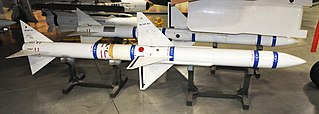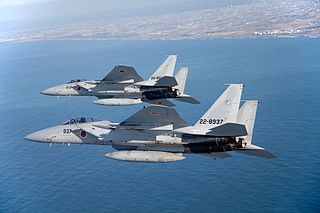
The AIM-7 Sparrow is an American medium-range semi-active radar homing air-to-air missile operated by the United States Air Force, United States Navy, United States Marine Corps, and various other air forces and navies. Sparrow and its derivatives were the West's principal beyond visual range (BVR) air-to-air missile from the late 1950s until the 1990s. It remains in service, although it is being phased out in aviation applications in favor of the more advanced AIM-120 AMRAAM.

The AIM-120 Advanced Medium-Range Air-to-Air Missile(AMRAAM) ( AM-ram) is an American beyond-visual-range air-to-air missile capable of all-weather day-and-night operations. It uses active transmit-receive radar guidance instead of semi-active receive-only radar guidance. When an AMRAAM missile is launched, NATO pilots use the brevity code "Fox Three".

The AIM-54 Phoenix is an American active radar-guided, beyond-visual-range air-to-air missile (AAM), carried in clusters of up to six missiles on the Grumman F-14 Tomcat, its only operational launch platform.

The Advanced Short Range Air-to-Air Missile (ASRAAM), also known by its United States designation AIM-132, is an imaging infrared homing air-to-air missile, produced by MBDA UK, that is designed for close-range combat. It is in service in the Royal Air Force (RAF), replacing the AIM-9 Sidewinder. The ASRAAM is designed to allow the pilot to fire and then turn away before the opposing aircraft can close for a shot. It flies at over Mach 3 to ranges in excess of 25 kilometres (16 mi). It retains a 50 g maneuverability provided by body lift and tail control.

The Mitsubishi F-2 is a multirole fighter derived from the General Dynamics F-16 Fighting Falcon, and manufactured by Mitsubishi Heavy Industries and Lockheed Martin for the Japan Air Self-Defense Force, with a 60/40 split in manufacturing between Japan and the United States. The basis of the F-2's design is the F-16 Agile Falcon, an unsuccessful offer by General Dynamics to provide a low-cost alternative for the Advanced Tactical Fighter (ATF) competition. Production started in 1996 and the first aircraft entered service in 2000.

An air-to-air missile (AAM) is a missile fired from an aircraft for the purpose of destroying another aircraft. AAMs are typically powered by one or more rocket motors, usually solid fueled but sometimes liquid fueled. Ramjet engines, as used on the Meteor, are emerging as propulsion that will enable future medium- to long-range missiles to maintain higher average speed across their engagement envelope.

The Vympel K-13 is a short-range, infrared homing air-to-air missile developed by the Soviet Union. It is similar in appearance and function to the American AIM-9B Sidewinder from which it was reverse-engineered. Although it since has been replaced by more modern missiles in frontline service, it saw widespread service in many nations.

The Hughes AIM-47 Falcon, originally GAR-9, was a very long-range high-performance air-to-air missile that shared the basic design of the earlier AIM-4 Falcon. It was developed in 1958 along with the new Hughes AN/ASG-18 radar fire-control system intended to arm the Mach 3 XF-108 Rapier interceptor aircraft and, after that jet's cancellation, the YF-12A. It was never used operationally, but was a direct predecessor of the AIM-54 Phoenix used on the Grumman F-14 Tomcat.

The Hughes AIM-4 Falcon was the first operational guided air-to-air missile of the United States Air Force. Development began in 1946; the weapon was first tested in 1949. The missile entered service with the USAF in 1956.
A beyond-visual-range missile is an air-to-air missile that is capable of engaging at ranges of 20 nmi (37 km) or beyond. This range has been achieved using dual pulse rocket motors or booster rocket motor and ramjet sustainer motor.

The Mitsubishi F-1 is a Japanese swept-wing, single-seat, twin-engine supersonic strike aircraft that was in service with the Japan Air Self-Defense Force (JASDF) from 1978 to 2006. It was Japan's first domestically designed and built supersonic combat aircraft, jointly developed by Mitsubishi Heavy Industries. It is essentially a T-2 trainer airframe modified for a dedicated anti-ship and ground attack role.

The Mitsubishi AAM-3 or Type 90 air-to-air missile (90式空対空誘導弾) is a short-range all-aspect air-to-air missile developed by Japan. It has been officially operated since 1991, and is expected to ultimately replace the US AIM-9 Sidewinder.
The Mitsubishi AAM-4 is a medium-range active radar homing air-to-air missile. It is a modern beyond-visual-range missile developed in Japan and intended to replace the semi-active radar homing AIM-7 Sparrow missile in service. It has been operational since 1999. The main contractor is Mitsubishi Electric. The 2010 AAM-4B was the world's first air-to-air missile with an AESA radar seeker.

The Mitsubishi AAM-5 is a short-range air-to-air missile developed and produced by Mitsubishi Heavy Industries for the Japan Air Self-Defense Force. Development of the missile as a replacement for the AAM-3 missile commenced in 1991, and it has been operational since 2004.

The Mitsubishi AAM-2 was a Japanese prototype for a limited all aspect infrared homing air-to-air missile developed based on the American AIM-4D Falcon missile. It never reached production.

The Sky Sword 1, or TC-1, is a short range infrared guided air-to-air missile. The missile has fire and forget slave-by-radar capabilities. It consists of an imaging infrared seeker, a high explosive warhead, a solid propellant motor and a guidance control unit. The seeker uses dual spectral IR and has a detection range of 18.5km. The Sky Sword 1 is also used as a surface-to-air missile by the Antelope air defence system.

The AIM-9 Sidewinder is a short-range air-to-air missile. Entering service with the United States Navy in 1956 and the Air Force in 1964, the AIM-9 is one of the oldest, cheapest, and most successful air-to-air missiles. Its latest variants remain standard equipment in most Western-aligned air forces. The Soviet K-13, a reverse-engineered copy of the AIM-9B, was also widely adopted.

The PL-2 is an infrared homing (IRH) air-to-air missiles (AAM) developed in the People's Republic of China (PRC). It was a reverse-engineered Soviet Vympel K-13, which in turn was a reverse-engineered American AIM-9B Sidewinder.

The Mitsubishi F-15J/DJ Eagle is a twin-engine, all-weather air superiority fighter based on the McDonnell Douglas F-15 Eagle in use by the Japan Air Self-Defense Force (JASDF). The F-15J was produced under license by Mitsubishi Heavy Industries. The subsequent F-15DJ and F-15J J-MSIP variants were also produced. Japan is the largest customer of the F-15 Eagle outside the United States. In addition to combat, F-15DJ roles include training. The F-15J Kai is a modernized version of the F-15J. Kai was an early designation that has gradually subdivided; nowadays, Japan no longer uses 'kai' to refer to newly upgraded F-15Js. Instead, Japanese predominantly use J-MSIP or F-15MJ.

The 303rd Tactical Fighter Squadron is a squadron of the 6th Air Wing of the Japan Air Self-Defense Force (JSDF) based at Komatsu Air Base, in Ishikawa Prefecture, Japan. It is equipped with Mitsubishi F-15J/DJ and Kawasaki T-4 aircraft.


















